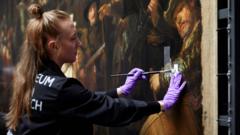The Rijksmuseum in Amsterdam embarks on a groundbreaking restoration of Rembrandt’s iconic painting, The Night Watch, involving cutting-edge techniques and public engagement.
Restoration of Rembrandt’s Night Watch Kicks Off at Rijksmuseum

Restoration of Rembrandt’s Night Watch Kicks Off at Rijksmuseum
Major conservation efforts unveiled to reveal the true colors of a masterpiece.
The Rijksmuseum in Amsterdam has commenced the largest restoration of Rembrandt’s esteemed artwork, The Night Watch. This significant undertaking, known as "Operation Night Watch," follows five years of research, incorporating advanced technologies including digital imaging and artificial intelligence. During this initial phase, eight skilled restorers will systematically remove the varnish that has coated the painting since its last restoration in 1975-76. This process takes place in a glass-enclosed area within The Night Watch Room, allowing the public to witness the meticulous process firsthand.
Rijksmuseum director Taco Dibbits expressed excitement about this historic restoration, stating, “The start of the restoration is thrilling. Removing the varnish will reveal The Night Watch’s eventful history. It will be a unique experience for the public to follow this process up close.” The restoration team employs microfibre cloths and cotton swabs to carefully lift the accumulated varnish, which has darkened the painting over the years, obscuring its original hues.
The Night Watch, an iconic example of Dutch Golden Age art, was created by Rembrandt van Rijn in 1642 for Amsterdam's Arquebusiers Guild Hall. The painting features a dramatic depiction of a captain commanding the formation of guardsmen, employing masterful use of light to draw attention to key figures and details within the scene. Its original title, Militia Company of District II under the Command of Captain Frans Banning Cocq, was later abbreviated to The Night Watch, a name that emerged in the 18th century.
Over the years, The Night Watch has suffered various attacks, including knife cuts and an acid spray incident in 1990, leading to 25 restoration treatments overall. Nonetheless, this latest project aims to uncover its true character, with over two million visitors flocking to the museum each year to experience the artwork. The emphasis on public involvement in the restoration process marks a notable evolution in how art conservation is shared and appreciated by audiences worldwide.
Rijksmuseum director Taco Dibbits expressed excitement about this historic restoration, stating, “The start of the restoration is thrilling. Removing the varnish will reveal The Night Watch’s eventful history. It will be a unique experience for the public to follow this process up close.” The restoration team employs microfibre cloths and cotton swabs to carefully lift the accumulated varnish, which has darkened the painting over the years, obscuring its original hues.
The Night Watch, an iconic example of Dutch Golden Age art, was created by Rembrandt van Rijn in 1642 for Amsterdam's Arquebusiers Guild Hall. The painting features a dramatic depiction of a captain commanding the formation of guardsmen, employing masterful use of light to draw attention to key figures and details within the scene. Its original title, Militia Company of District II under the Command of Captain Frans Banning Cocq, was later abbreviated to The Night Watch, a name that emerged in the 18th century.
Over the years, The Night Watch has suffered various attacks, including knife cuts and an acid spray incident in 1990, leading to 25 restoration treatments overall. Nonetheless, this latest project aims to uncover its true character, with over two million visitors flocking to the museum each year to experience the artwork. The emphasis on public involvement in the restoration process marks a notable evolution in how art conservation is shared and appreciated by audiences worldwide.























